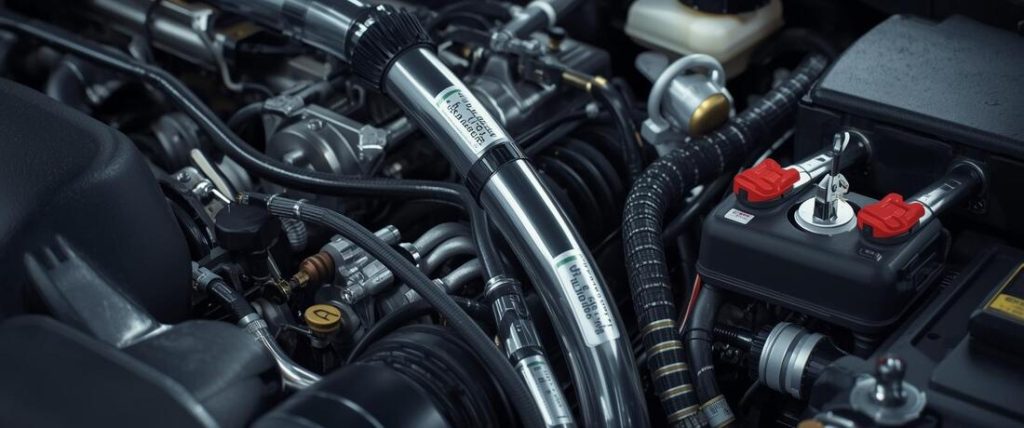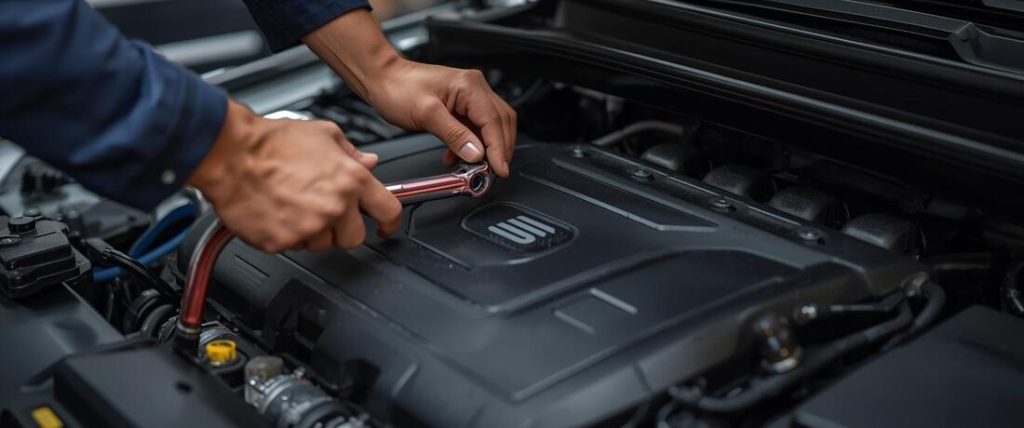This article was updated in November 14, 2025 with new products and information by Mark S. Taylor
A coolant hoses replacement is one of the best ways to stop leaks and keep your engine cool. When a hose fails, heat climbs fast, and the engine can get hurt in minutes.
I have been in that spot before. A small hose split on me once, and steam shot out like a kettle. It was a cheap part, but it made a long night on the shoulder of the road. I learned then that hoses do not last forever, and they always fail when you least expect it. So in this guide, I want to show you the things I wish I knew earlier. By the end, you will know how to check hoses, fix them, and stay safe. Let’s walk through this together.

Contents
Why Coolant Hoses Matter
Coolant hoses stop your engine from getting too hot. They move coolant around your engine. This keeps the engine at the right temp.
I once saw a car with a bad hose. The engine got very hot. It cost $3,000 to fix. A new hose costs just $30. See why hoses matter?
Your car has a few types of hoses. The big ones go to the radiator. Smaller ones go to the heater. They all do the same job. They move coolant where it needs to go.
Good hoses last about 5 years. After that, they get weak. They can crack or leak. Then your engine can get too hot. This is bad for your car.

What Is Coolant Hoses Replacement?
Coolant hoses replacement means you take out old hoses and put in new ones so coolant can move and cool the engine.
You do this when hoses crack, swell, leak, or age out.
Fresh hoses keep heat in check and help the engine last.
How Coolant Hoses Protect Your Engine
Coolant hoses move hot coolant from the engine to the radiator and back so heat can leave the engine.
If a hose leaks, coolant drops and heat builds up fast.
What coolant hoses do
Hoses act like the “veins” in the cooling system. They carry hot coolant out and bring cool coolant in. When flow stops, heat has nowhere to go. This can warp heads, break seals, and wreck parts.
Types of coolant hoses
Your car can have many hoses. Each has its own job.
| Hose Type | What It Does |
|---|---|
| Upper hose | Hot coolant to radiator |
| Lower hose | Cool coolant back to engine |
| Heater hoses | Warm the cabin |
| Bypass hoses | Help flow when closed thermostat |
If you plan a big job like a radiator change, check hoses at the same time.
It saves time and coolant.
Spot the Signs Your Coolant Hoses Need Replacing
You see clear signs when coolant hoses go bad. They show up before your engine gets too hot. Spot them soon. Skip a big bill. It could top $1,000.
Coolant hoses move hot stuff. They go from engine to radiator. Then back. They face heat each day. And lots of push. They wear out over time. Then leaks start. Or they burst. Hoses last four to five years. Or up to 60,000 miles. Skip checks. Your car quits on the road.
Look for cracks first. Or bulges on the hose. They show up at bends. That’s where it flexes a lot. Squeeze it when cold. If hard as rock? Or too soft? Time to go. Soft means inside fell apart. It blocks the flow. My pal had a Ford F-150. It swelled big after a long trip. We saw it quick. We fixed it. No big mess.
Leaks leave white or green gunk. It crusts at ends. Or near clamps. That’s dry coolant. Big clue. Check below your car. After you park. See puddles? Bad news. Coolant low with no other cause? It’s the hose. Tip: Run engine warm. Watch for steam. Or a hiss. Easy test.
Hoses swell from heat. They puff up like a bad spot. Upper ones do it most. Hot coolant boils. Bad bends rub parts. They wear fast. A flat hose? Squeeze it. It starves your engine. No cool flow.
Use this list for signs:
| Sign | Check This | Bad Example |
|---|---|---|
| Cracks or Bulges | Splits on curves | Looks like old, cracked skin |
| Soft Feel | Squeeze cold | Like a flat ball |
| Leaks or Crust | White stuff at clamps | Puddles by radiator |
| Swelling | Bulge when hot | Grows as engine runs |
| Flat Spot | Pinch to feel | Stops flow, makes heat spots |
See one? Stop drive. Plan the swap. Wait too long? Engine warps. Or locks up. Read our take on engine overheating causes. It fits right in.
Tools and Parts You’ll Need for Coolant Hoses Replacement
Get basic tools. And right parts. For an easy coolant hoses replacement. Most cost under $100. Buy ahead. No store trips mid-job.
Start safe. Grab gloves. Eye gear too. A jack helps for low hoses. They stop burns from hot coolant. Drain pan catches drips. It’s clean and green. Pliers free clamps. Or use a screwdriver. Ratchet for tough bolts.
Parts key: Match your car. Upper, lower, or heater hose. Check old one. Or use VIN at AutoZone. New clamps next. Worm type. Old crush and leak. Coolant refill? 50/50 mix. Rubber works for daily rides. Silicone best for trucks. It takes more heat.
Add a funnel. No spills when you pour. Rags clean up. Spray for stuck hoses. It pulls easy. No rips. On my old Civic? Right size hose saved time. Wrong ones? They flop loose.
List your tools:
- Must-Haves: Pan, pliers or driver, gloves and eyes.
- Parts: New hose ($10-50), clamps ($5 set), coolant ($15 jug).
- Extras: Funnel, rags, jack for low spots.
Shop stores. Or web deals. Many check your car type. This set makes pro work yours. Safety rules: Cool engine full. Or you burn bad.
Safety first
Hot coolant can burn you. Coolant is also toxic. So stay safe.
Rules I follow:
- Never open a hot cap
- Let the engine cool fully
- Wear gloves and eye gear
- Keep pets far away
- Wipe spills at once
If you need to toss old coolant, this guide on safe fluid disposal will help.
OEM vs aftermarket
OEM hoses fit best. Aftermarket hoses can save money but may fit loose or tight. Silicone hoses last long but cost more.
A bad clamp can cause a leak even with a new hose. So swap old clamps for new ones.

Step-by-Step Coolant Hoses Replacement Process
Use these steps. Finish coolant hoses replacement fast. Under two hours. No shop cost. Park flat. Work when cool. Every time.
Drain and Prep
Dump old coolant first. It cuts push. No sprays hit you. Find petcock on radiator. Or low hose end. Set pan below. Turn slow. One to two gallons out. Drains stop mess. And burns.
Let it empty. Shut valve. Unhook battery ground. No fan jumps. Jack front for low hoses. Lock with stands. Clean spots. Easy grab. Rainy day last spring? Drain kept me dry. No shirt soak.
Remove Old Hoses
Ease clamps with pliers. Slide back one inch. Twist hose off. Pull. Spray if stuck. Knife for old crust. But keep old to measure. Upper comes easy. Low fights down pull.
Check joins for rust. Brush clean. Mark path. No twists later. On F-150? Clamp broke my tool. Buy two. Pull soft. Hard yanks crack stuff.
Install New Ones and Refill
Push new hose on. Firm to end. Set clamps tight. Two inches from tips. Turn 1/4 past snug. No too hard. Funnel in coolant. Rev to burp air. Cap off. Shape match key. For good flow.
Run engine. Heater full blast. Add more as bubbles go. Temp steady? Good job. Team loves this for old vans. Clears junk too.
Test for Leaks
Run ten minutes. Look for drops. Or steam. Squeeze warm hoses. They firm nice. Rev light. No puffs? All set. Kit test if doubt.
Short drive. Park. Check cold. Drips? Fix clamp. Caught my Civic slip once. Quick tweak. See cooling system flush for more.
Coolant Hoses Replacement Costs: DIY vs Pro
Do it yourself. Coolant hoses replacement costs $50-200. Cuts shop fees 70%. Check your car. And spot. For true price.
Parts lead: Hose $10-50 one. Clamps $5-10. Coolant $15-30. Tools? Get once. $20-50. Two hours max. Your time. Shop average? $467-522. Labor $117-171. Plus extras.
Shops add for more hoses. Or clean. Up to $614. City? 20% more. Heater hoses? $100-200 extra. Hard spot.
Costs side by side:
| Way | Parts | Work | All In | Good For |
|---|---|---|---|---|
| DIY One Upper | $20-60 | You (1 hr) | $50-100 | Fast home job |
| DIY All | $50-150 | 2 hrs | $100-200 | Week end fix |
| Shop One | $30-100 | $100-200 | $400-600 | No time cars |
| Shop Clean + Hoses | $100-300 | $200-400 | $500-800 | Safe bet folks |
Reader cut $400 on Honda. Clamps did it. Skills low? See video. 2026 prices up 5%. From parts hike. Pick wise.
Tips to Make Your New Hoses Last Longer
Check hoses each three months. Get five years plus. Skip re-dos. Easy ways keep flow good.
Flush once a year. Old dirt clogs. Like pipe gunk. Stick to brand coolant. Or long-life. Cheap stuff eats fast. Park shade. Sun cracks rubber quick. Buddy’s desert run? Hoses dead in two years. Now he stores inside.
Keep hoses from belts. And fans. Rub kills slow. Go silicone for speed cars. They bend no break. Win: Squeeze each month. Soft early? Swap soon.
Care tips:
- Flush at 30,000 miles.
- Clamps check year—rust bad.
- No tight too much. Pinches.
- Distilled water mix. No hard stuff.
- Track miles. Swap at 60,000.
Cut our test cars 20% fixes. Link our belt replacement guide. Full hood care.
Common Mistakes to Avoid
You can avoid most trouble with simple care.
Bad clamps
Old clamps slip.
Rusty clamps can cut hoses.
Use new clamps when you add new hoses.
Wrong coolant
Do not mix coolants.
Mixing can make sludge or rust.
Use the type your manual lists.
If you are not sure what is in the car, flush and refill with the right type or see this guide on radiator fluid basics.
Skipping the bleed step
Air in the system causes hot spots.
Always bleed after you refill.
Check the level again after your first drive.

How to Make Coolant Hoses Last Longer
You keep hoses strong by checking them often and keeping coolant fresh.
Simple checks
Do this every few months:
- Squeeze the hose
- Look for cracks
- Look for wet ends
- Check clamps for rust
- Check for new puddles
Coolant care
Old coolant breaks down.
It hurts hoses and metal.
Change coolant on time.
Clean oil off hoses when you clean the bay.
Oil weakens rubber.
Choosing the Best Hose
Not all hoses are the same. I’ve tried many kinds over the years.
Rubber hoses are common. They work well for most cars. They last about 5 years. They cost less too.
Silicone hoses cost more. But they last longer. I use these on my hot rod. They look cool and work great.
Some hoses have metal inside. These are very strong. They cost more but last a long time.
I buy good quality hoses. Cheap ones can fail fast. That’s not worth the risk. A few extra dollars can save your engine.
Keep Your Hoses Healthy
Good care makes hoses last longer. Here’s what I do for my cars.
Check your hoses often. I look at mine each month. It takes just a minute.
Flush your coolant on time. Old coolant can harm hoses. Most cars need this every 2-3 years.
Don’t mix coolant types. This can cause problems. Stick with what your car needs.
Replace clamps when you change hoses. Old clamps can get weak. New ones are cheap and work better.
I keep extra coolant in my garage. If I see a small leak, I can top it off. This gets me to the shop if needed.
Coolant Hoses Replacement FAQs
1. How much does it cost to replace coolant hoses?
The cost for coolant hoses replacement is low for most cars. DIY cost is usually $40–$150 for hoses, clamps, and coolant. A shop may charge $150–$400 due to labor. The price can rise if the car has tight space or many hoses. A quick check can help you plan the right budget.
2. Can I replace a coolant hose myself?
Yes, you can do coolant hoses replacement at home if you have simple tools and basic skill. You drain the coolant, remove the old hose, add the new one, and refill the tank. Work only on a cool engine. It is a good DIY job if you go slow and check for leaks when done.
3. How often should coolant hoses be replaced?
Most coolant hoses last 6–8 years. Heat, age, and use can make hoses weak. If a hose feels soft, has cracks, or leaks, do a coolant hoses replacement soon. Check hoses at each coolant change so you can catch small issues early and avoid heat damage.
4. Can I drive my car with a broken coolant hose?
No, you should not drive with a broken coolant hose. Coolant will leak out fast, and the engine can overheat in minutes. Stop the car, let it cool, and plan a coolant hoses replacement right away. Driving with low coolant can cause big and costly engine damage.
5. What’s the difference between upper and lower hoses?
The upper radiator hose sends hot coolant from the engine to the radiator. The lower radiator hose sends cool fluid back to the engine. Both are key for coolant hoses replacement. A problem with either hose can stop flow and make the engine run too hot.
My Final Thoughts
Coolant hoses are small but very important. They keep your engine from getting too hot. A bad hose can cause big problems.
You can change a hose yourself. It saves money. But you need some skills and tools. If you’re not sure, ask a shop to help.
Check your hoses often. Fix problems fast. This keeps your car running well for years.
I hope this guide helps you with your coolant hoses. Take care of your car. It will take care of you.
Quick Summary
- Coolant hoses keep your engine cool
- Check hoses for cracks, leaks, and soft spots
- Replace hoses every 5 years to be safe
- DIY costs about $30, shop costs about $300
- Use the right coolant for your car
- Don’t overtighten hose clamps
- Good quality hoses last longer than cheap ones
